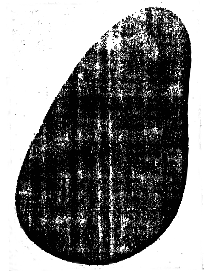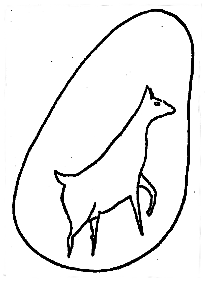
The Discovery of British Palaeoglyphs
W. J. Lewis Abbott
The Sphere January 1914

Pebble Bearing Engravying of Goat
The pebble is of dark brown quartzite 3 in. long
[232] While searching for prehistoric treasures in the fields of the parish of Nayland, Suffolk, my friend, the Rev. J. D. Gray, picked up a stone which he thought to be a rubber, i.e., a stone employed in the dressing of skins. This he took home to get his opinion confirmed by others who had more experience of these things. Subsequently he submitted it to the writer. Immediately we were struck with the engraved lines, and upon further washing and scrubbing it became evident that we had here the first discovered example of a British palaeoglyph.
The stone in question is a dark brown quartzite pebble some 3 in. long; its angles have been rounded off in the vicissitudes of gravel-making until it is fairly ovoid. Nature, however, has been further disrupting a lunette-shaped piece and leaving a concavity over a greater part of one side of the stone. It is in this hollow that the engraving has been effected.
The illustration is a tracing of this: it represents a (nanny) goat in the act of climbing. It is marked by that boldness and firmness of outline which is characteristic of palaeolithic technique. Numerous examples of this creature have been found in various caverns and rock shelters in various parts of the Continent associated with the other pleistocene animals, and in some cases the outline is exactly identical with that on the Nayland stone. Although there are certain features which are similar in nanny goats and fawns there is one that always characterises the goat, and that is the upturned tail, and this feature comes out very prominently in the Nayland and certain French examples. Despite the faithfulness of many of the palaeolithic examples of the representations of animals it has frequently been pointed out how very rarely the old artists showed the feet of the creatures they portrayed. It has been suggested that this was due to the fact that they sketched from life, under which circumstances the feet were covered with the vegetation or were not visible at the distance from the object. The Nayland specimen shows this peculiarity, and the fact that the uplifted leg shows a foot goes to support this theory.
But there is one feature about the stone not to be found in any continental specimen, and that is the material of which it is made. At this time man was in the stone age, and the hardest material he was supposed to know was flint. It is, however, obvious that he could not incise a hard quartzite–the hardest of our stones–with a flint which is softer. The first objection to the age of the engraving that suggested itself to me was its superior hardness. Upon consideration I realised that certain quartz crystals sometimes modified their pyramidal faces until they assume the same shape points as were put upon his burin by palaeolithic man. I therefore obtained a similar quartzite from the same field, selected a quartzite from my collection with one of these points, and found that I was able to engrave the figure of a horse upon the quartzite with one of these nature-supplied gravers. As such crystals would continuously meet the eye of the palaeolithic hunter they would, of course, strike him as ready-made gravers or burins of a special beauty and curiosity. When he tried these he would soon find their superior cutting power, and presently he would discover their magic in cutting stones that nothing else would. We have then in this Nayland quartzite the birth of the glyphic art, the great development of which we so much admire in early peoples such as the Babylonians, Egyptians, Greeks, and Romans.

Outline of Goat on Pebble
This outline has been traced from the quartzite pebble shown